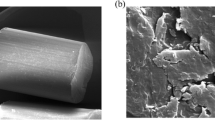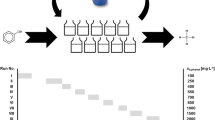Abstract
We investigated the effect of different oxygen regimes on growth patterns of Pseudomonas spp. during benzene degradation in microcosm batch studies. Benzene degradation was induced by limiting oxygen available for microbial activity, which consists of three initial-dissolved oxygen (DO) levels of oxic, hypoxic, and anoxic conditions. Batch experiments were performed for cell growth and benzene degradation by inoculating three strains of Pseudomonas spp. (Pseudomonas aeruginosa, Pseudomonas fluorescens, Pseudomonas putida) in mineral salt medium containing aqueous benzene. Results showed that all strains were capable to grow and degrade benzene under all oxygen regimes but in a different manner. The highest cell growth of P. aeruginosa and P. fluorescens was achieved under oxic and anoxic condition, respectively, but there was no substantial difference on benzene degradation between the oxygen treatments with about 25% reduction for both strains. P. putida showed a facultative process for both cell growth and benzene degradation. This reveals that care should be taken in selection of microorganisms with regard to environmental studies since they exhibit different responses for given environmental conditions such as DO levels.


Similar content being viewed by others
References
Anderson RT, Lovley DR (2000) Anaerobic bioremediation of benzene under sulfate-reducing conditions in a petroleum-contaminated aquifer. Environ Sci Technol 34:2261–2266
Burland SM, Edwards EA (1999) Anaerobic benzene biodegradation linked to nitrate reduction. Appl Environ Microbiol 65:529–533
Chiang CY, Salanitro JP, Chai EY, Colthart JD, Klein CL (1989) Aerobic biodegradation of benzene, toluene and xylene in a sandy aquifer-data analysis and computer modeling. Ground Water 27:823–834
Coates JD, Anderson RT, Woodward JC, Phillips EJP, Lovely DR (1996) Anaerobic hydrocarbon degradation in petroleum-contaminated harbor sediments under sulfate-reducing and artificially imposed iron-reducing conditions. Environ Sci Technol 30:2784–2789
Coates JD, Bruce RA, Haddock JD (1998) Anoxic bioremediation of hydrocarbons. Nature 396:730
Coates JD, Chakraborty R, Lack JG, O'Connor SM, Cole KA, Bender KS, Achenbach LA (2001) Anaerobic benzene oxidation coupled to nitrate reduction in pure culture by two strains of Dechloromonas. Nature 411:1039–1043
Gibson DT, Cardini GE, Maseles FC, Kallio RE (1970) Incorporation of oxygen-18 into benzene by Pseudomonas putida. Biochemistry 9:1631–1635
Grbi'c-Gali'c D, Vogel T (1987) Transformation of toluene and benzene by mixed methanogenic cultures. Appl Environ Microbiol 53:254–260
Kim DJ, Choi JW, Choi NC, Mahendran B, Lee CE (2005) Modeling of growth kinetics of Pseudomonas spp. during benzene degradation. Appl Microbiol Biotechnol (in press)
Leahy JG, Olsen RH (1997) Kinetics of toluene degradation by toluene-oxidizing bacteria as a function of oxygen concentration, and the effect of nitrate. FEMS Microbiol Ecol 23:23–30
Lovley DR, Woodward JC, Chapelle FH (1994) Stimulated anoxic biodegradation of aromatic hydrocarbons using Fe(III) ligands. Nature 370:128–131
Lovley DR, Coates JD, Woodward JC, Phillips EJP (1995) Benzene oxidation coupled sulfate reduction. Appl Environ Microbiol 61:953–958
Lovley DR, Woodward JC, Chapelle FH (1996) Rapid anaerobic benzene degradation with a variety of chelated Fe(III) forms. Appl Environ Microbiol 62:288–291
Major DW, Mayfield CI, Barker JF (1988) Biotransformation of benzene by denitrification in aquifer sand. Ground Water 26:8–14
Mikesell MD, Kukor JJ, Olsen RH (1994) Metabolic diversity of aromatic hydrocarbon-degrading bacteria from a petroleum-contaminated aquifer. Biodegradation 4:249–259
Morgan P, Lewis ST, Watkinson RJ (1993) Biodegradation of benzene, toluene, ethylbenzene and xylenes in gas-condensate-contaminated ground-water. Environ Pollut 82:181–190
Nicholson CA, Fathepure BZ (2004) Biodegradation of benzene by halophilic and halotolerant bacteria under aerobic conditions. Appl Environ Microbiol 70:1222–1225
Ridgeway HF, Safarik J, Philipps D, Carl P, Clark D (1990) Identification and catabolic activity of well-derived gasoline-degrading bacteria from a contaminated aquifer. Appl Environ Microbiol 56:3565–3575
Rooney-Varga JN, Anderson RT, Fraga JL, Ringelberg D, Lovley DR (1999) Microbial communities associated with anaerobic benzene mineralization in a petroleum-contaminated aquifer. Appl Environ Microbiol 65:3056–3063
Shim H, Yang ST (1999) Biodegradation of benzene, toluene, ethylbenzene, and o-xylene by a coculture of Pseudomans putida and Pseudomans fluorescens immobilized in a fibrous-bed bioreactor. J Biotechnol 67:99–112
Shim H, Hwang B, Lee S, Kong S (2005) Kinetics of BTEX biodegradation by a coculture of Pseudomonas putida and Pseudomonas fluorescens under hypoxic conditions. Biodegradation 16:319–327
Vogt C, Simon D, Alfreider A, Babel W (2004) Microbial degradation of chlorobenzene under oxygen-limited conditions leads to accumulation of 3-chlorocatechol. Environ Toxicol Chem 23:265–270
Weiner J, Lovley DR (1998) Rapid benzene degradation in methanogenic sediments from a petroleum-contaminated aquifer. Appl Environ Microbiol 64:1937–1939
Wilson LP, Bouwer EJ (1997) Biodegradation of aromatic compounds under mixed oxygen/denitrifying conditions: a review. J Ind Microbiol Biotech 18:116–130
Yeh WK, Gibson DT, Liu TN (1977) Toluene dioxygenase: a multicomponent enzyme system. Biochem Biophys Res Commun 87:401–410
Acknowledgements
This study was supported by ABRL project (Grant R14-2002-049-01000-2) of Korea Science and Engineering Foundation.
Author information
Authors and Affiliations
Corresponding author
Rights and permissions
About this article
Cite this article
Mahendran, B., Choi, NC., Choi, JW. et al. Effect of dissolved oxygen regime on growth dynamics of Pseudomonas spp during benzene degradation. Appl Microbiol Biotechnol 71, 350–354 (2006). https://doi.org/10.1007/s00253-005-0152-1
Received:
Revised:
Accepted:
Published:
Issue Date:
DOI: https://doi.org/10.1007/s00253-005-0152-1




